- Investigation on Cissus Quadrangularis Stem Fiber Reinforced Novel Polymeric Composite with Banana Chopped Fiber for Green Engineering Applications
Veeramalai Chinnasamy Sathish Gandhi†
 , Narayanan Sreeraman*
, Narayanan Sreeraman*  , Radhakrishnan Kumaravelan**
, Radhakrishnan Kumaravelan**  , and Thirugnanasambandan Surendiran***
, and Thirugnanasambandan Surendiran*** 
Department of Mechanical Engineering, University College of Engineering, BIT Campus, Anna University, Tiruchirappalli - 620024, Tamilnadu, India.
*Business Development Department, TEFUGEN Technologies Private Limited, Tiruchirappalli - 620015, Tamilnadu, India.
**Department of Mechanical Engineering, Velalar College of Engineering and Technology, Erode - 638012, Tamilnadu, I- 친환경 공학 응용을 위한 Cissus Quadrangularis 줄기 및 바나나 섬유 기반 고분자 복합재 연구
Reproduction, stored in a retrieval system, or transmitted in any form of any part of this publication is permitted only by written permission from the Polymer Society of Korea.
This study investigates the potential of a novel hybrid composite material made from Cissus quadrangularis fibers (CQF) and banana fibers (BF) for use in sustainable engineering and construction applications. Using the hand layup technique, the composite was fabricated with varying CQF content (0 wt% to 100 wt%) in an epoxy resin matrix. Analytical techniques, including Fourier transform infrared spectroscopy (FTIR), X-ray diffraction (XRD), and scanning electron microscopy (SEM), revealed significant structural modifications in the treated fibers. Mechanical and tribological tests assessed the hardness, wear rate, and coefficient of friction. Results showed that the composite with 20 wt% CQF had an 11.32% increase in hardness, while the 100 wt% CQF composite achieved a 1.4% reduction in wear rate. The composite with 60 wt% CQF notably improved the coefficient of friction. This research demonstrates the potential for using CQF and BF to create sustainable composite materials with enhanced performance properties.
Cissus quadrangularis (CSQ) and banana fibers (BF) were alkali-treated and analyzed using Fourier transform infrared spectroscopy (FTIR), X-ray diffraction (XRD), and scanning electron microscopy (SEM). Six epoxy composites with varying CSQ : BF ratios were tested for hardness and wear. Treatment improved fiber bonding and structure. Sample S5 (80:20) showed highest hardness; Sample S2 (20: 80) had better wear resistance. These composites are suitable for automotive, panelling, and eco-friendly construction applications.
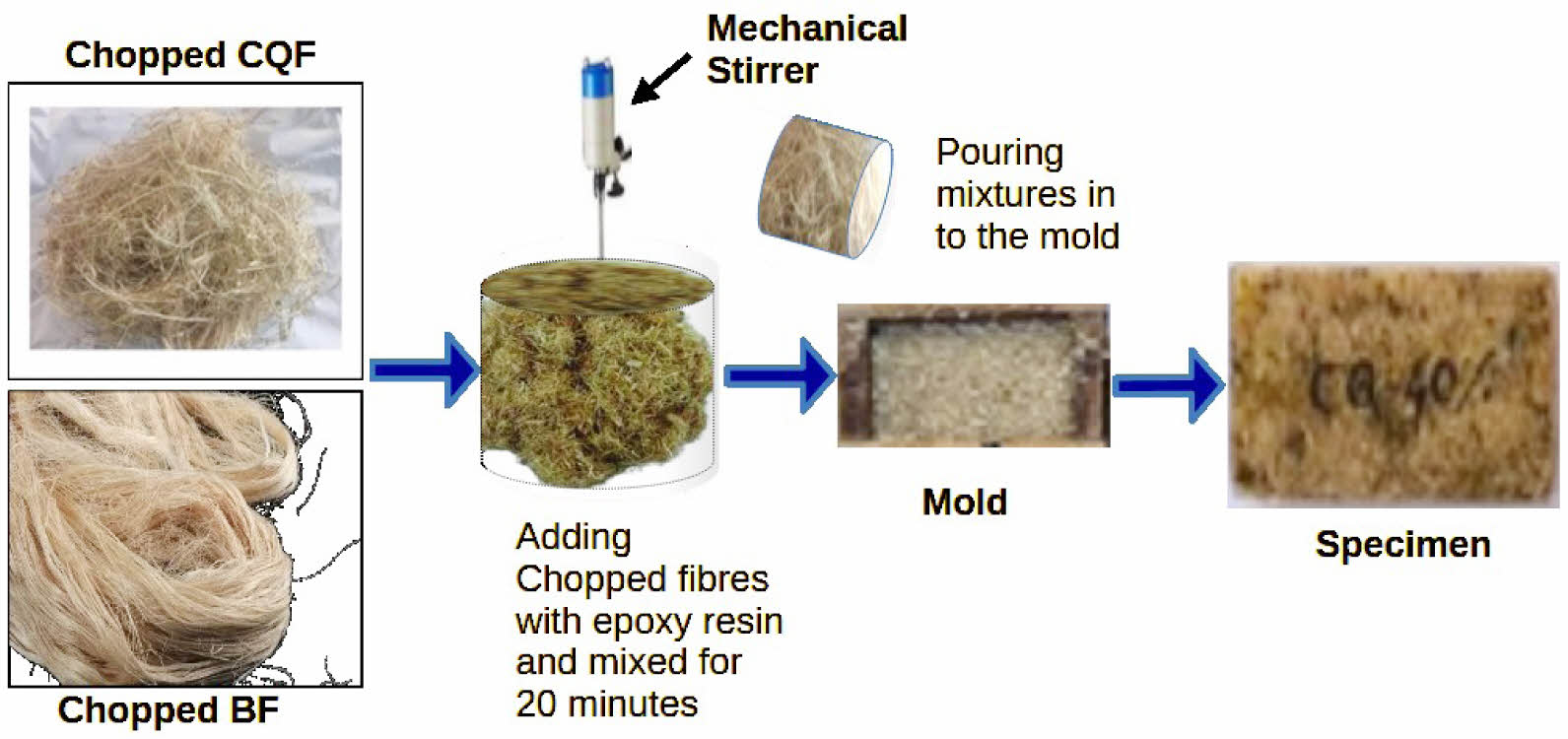
Keywords: natural fibres, epoxy resin, hand layup, morphology, tribology characteristics.
Thanks for the financial support of M/s. Dassault Systèmes LA Foundation for this research work carried out under the sponsored research project scheme (ID Number: IN-2020-011). And also work supported by Department of Mechanical Engineering, University College of Engineering, BIT Campus, Anna University, Tiruchirappalli, Tamilnadu, India.
The authors declare that they have no competing interests.
Natural fibers have gained significant attention in recent years as reinforcing materials in composite structures due to their eco-friendliness, cost-effectiveness, and excellent mechanical properties.1-8 Cissus quadrangularis, commonly known as the Veldt Grape, is a perennial plant widely used in traditional medicine. The fibers extracted from this plant are known for their high strength and durability, making them suitable for reinforcement in composite materials. Banana Fiber (BF), derived from the pseudostem of the banana plant, is another natural fiber with significant potential in composite materials.9-14 This study focuses on a new composite made from stem fiber (CQSF) and chopped banana fiber. Unlike other studies that mainly use fibers like jute, sisal, or flax, we combine CQSF and banana fibers to create a stronger, more durable material. Most past research has looked at single fiber composites, but this work examines the synergistic effect of using two fibers together. We also treat the fibers with alkali, which helps them bond better with the polymer, improving the composite's performance. This study offers a greener, more sustainable alternative for applications in areas like automotive, aerospace, and construction.15 X-ray diffraction (XRD) analysis of CQF reveals its crystal-line nature, which contributes to its high mechanical strength. The characteristic peaks in the XRD pattern indicate the presence of cellulose, hemicellulose, and lignin in the fiber structure.16-21 Fourier-transform infrared (FTIR) spectroscopy provides insight into the functional groups present in CQF, confirming the pres-ence of hydroxyl groups, which are essential for bonding with polymer matrices in composites FTIR spectra of BF reveal the presence of functional groups such as hydroxyl, carboxyl, and acetyl, which facilitate interaction with polymer matrices.22-23 Scanning electron microscopy (SEM) images of CQF show a rough surface morphology, which enhances the interfacial adhesion between the fiber and the polymer matrix.24-26 SEM analysis of Banana Fibers demonstrates a relatively smooth sur-face with some fibrillation, which can contribute to good inter-facial bonding in composites.27 Mechanical properties such as hardness, tensile strength, flex-ural strength, and impact resistance are critical for evaluating the performance of composite materials and their studies have shown that the inclusion of CQF with banana composites enhances hardness, tensile strength and modulus due to its high cellulose content and crystalline nature.28-31 Tribological studies, which focus on the friction, wear, and lubrication properties of materials, are essential for evaluating the performance of composites in dynamic applications.32-33 The inclusion of fibre composites has been shown to reduce the coefficient of friction and wear rate due to its high hardness and surface roughness with its relatively smooth surface, con-tributes to reduced wear by forming a protective layer during sliding contact.34-40 The implication of natural fibers offer substantial benefits as reinforcement materials in composite applications. and their favorable characteristics, including high tensile strength, hard-ness, good interfacial bonding with matrices, and excellent wear resistance, make them viable alternatives to synthetic fibers in various engineering applications.41-50
Materials and Methods. Materials: Natural fibers were sourced from the mature stems of Cissus quadrangularis and banana plants. The Cissus quadrangularis fibers, which do not contain pectin, were collected from Trichy, India. The extraction process involved harvesting the stems, retting, and subsequent processing. In contrast, the banana stems, containing pectins ranging from 0.15% to 1%, were collected from Lagudi, India. These banana stems were washed, dried, and mechanically processed using a hammering technique to extract the fibers, as shown in Figure 1. Epoxy resin, selected for its excellent adhesive properties and mechanical strength, was used as the matrix material for the composite.
Fiber Treatment: To enhance the bonding of natural fibers with the epoxy matrix, an alkaline treatment was applied to both types of fibers. This process involved preparing a 5% calcium hydroxide (Ca(OH)2) solution by dissolving Ca(OH)2 in distilled water. The fibers were immersed in this solution for 2-3 days to remove impurities and increase surface roughness. After immersion, the fibers were thoroughly rinsed with distilled water to eliminate any residual Ca(OH)2, as shown in Figure 2. Finally, the cleaned fibers were dried at laboratory oven controlled temperature (36-38 ℃) for 1-2 days to ensure complete moisture removal.
Analysis of Fibres. FTIR Analysis: Fourier Transform Infrared (FTIR) analysis is a powerful technique is used to identify and characterize chemical compounds based on their absorption of infrared light. By measuring the specific wavelengths of light absorbed by sample molecules, FTIR spectroscopy provides valuable information about molecular structure and functional groups present as shown in Table 1.
The FTIR analysis of Cissus quadrangularis fiber and banana fibre before and after treatment reveals significant modifications in its chemical structure are shown in Figure 3.
Before treatment, the fiber shows characteristic peaks indicating the presence of functional groups such as O-H stretching (3328.15 cm-1), C-H stretching (2916.28 cm-1, 2848.48 cm-1), C=C stretching from alkenes or aromatic rings (1654.32 cm-1, 1637.24 cm-1, 1617.85 cm-1), N-H bending (1541.57 cm-1), and C-O stretching (1241.81 cm-1, 1028.25 cm-1). Post-treatment, there are noticeable shifts and new peaks, such as O-H stretching at 3328.37 cm-1, C≡C or C≡N stretching at 2037. 90 cm-1 and 1800.45 cm-1, and altered C-O stretching peaks, indicating the introduction of new functional groups and changes in hydrogen bonding and the bonding environment.
Similarly, the FTIR analysis of banana fiber shows significant structural changes after treatment. Before treatment, the fiber's spectrum displays peaks associated with O-H stretching (3328.80 cm-1), C-H stretching (2916.91 cm-1), C=C stretching (1601.75 cm-1), and various C-O stretching peaks (1242.20 cm-1, 1159.41 cm-1, 1032.01 cm-1). Post-treatment, the spectrum indicates major shifts and new peaks, such as O-H stretching at 3349.11 cm-1, C≡C or C≡N stretching at 2181.02 cm-1, 2019.81 cm-1, and 1978.01 cm-1, and changes in C-O stretching peaks, signifying the incorporation of new functional groups and modifications in the existing ones. These observations highlight the chemical alterations induced by the treatment process, which can affect the fibers' properties and potential applications.
X-Ray Diffraction Analysis: X-ray diffraction (XRD) is a powerful analytical technique used to determine the crystallographic structure, chemical composition, and physical properties of materials. In XRD, a sample is bombarded with X-rays generated by a cathode ray tube, typically with a copper anode. The X-rays diffract upon interacting with the crystal lattice of the material, and these diffracted rays are detected using a detector, usually a scintillation or charge-coupled device (CCD) detector. The resulting diffraction pattern, which shows intensity versus angle (2θ), is unique to the material's
structure and is analyzed using software to identify phases and crystal structures. The primary equipment components include the X-ray source (usually a Cu-Kα radiation source), a sample holder, a goniometer for precise angle measurements, and the detector. Sample preparation involves finely grinding the material to ensure homogeneity.The XRD analysis of Cissus quadrangularis fiber and banana fibre before and after treatment reveals significant modifications in molecular arrangements are shown in Figure 4.
Before treatment, the XRD analysis of Cissus quadrangularis fibre shows characteristic peaks at 14.274°, 15.068°, and 16.65°. These values indicate the crystalline regions within the fibre's natural structure. After treatment, the XRD peaksshift to 15.172° and 15.687°, suggesting alterations in the crystalline structure due to the treatment process. The changes in peak positions reflect modifications in the molecular arrangement and possible improvements in the fibre's crystallinity, indicating a successful alteration of its structural properties through the treatment process.
In the case of banana fibre, the XRD analysis before treatment reveals peaks at 12.35°, 13.95°, and 22.54°. These peaks represent the fibre's initial crystalline structure. After treatment, the XRD peaks shift to 12.859°, 16.134°, 27.707°, and 29.30°. The emergence of new peaks and the shift in existing ones indicate significant changes in the crystalline structure of the banana fibre. These changes suggest that the treatment process has effectively modified the fibre's molecular structure, potentially enhancing its crystallinity and overall material properties.
Scanning Electron Microscopy (SEM): In this study, a SEM instrument equipped with high-resolution imaging capabilities was employed to delve into the fiber-matrix interface and fiber dispersion within the composite. The procedure involved meticulously preparing samples by coating them with a thin layer of gold, a common practice aimed at enhancing conductivity and minimizing charging effects during imaging. Micrographs were then captured at 4000X magnification to meticulously scrutinize the microstructural characteristics of the composite material. This multi-scale approach enabled the observation of fine details, such as the alignment of fibers, the distribution of the matrix material, and any potential defects or irregularities present within the composite structure. Scanning Electron Microscopy (SEM) analysis provides detailed visual evidence of the structural changes in Cissus quadrangularis and banana fibers before and after treatment with calcium hydroxide, as depicted in Figure 5. Before treatment, Figure 5(a) illustrates Cissus quadrangularis fibers with a rugged surface, irregularities, and bundled structures typical of their natural state. The SEM images reveal varying pore sizes and distributions, emphasizing the heterogeneous nature of these fibers. In contrast, Figure 5(c) shows banana fibers with a smoother surface and less pronounced pore distribution, reflecting their inherent structural uniformity.
Following treatment with calcium hydroxide, SEM analysis Figure 5(a) and 5(b) for Cissus quadrangularis and Figure 5(c) and 5(d) for banana fibers demonstrate significant modifications in surface morphology and structural integrity. Figure 5(a) and 5(c) indicate that the alkaline treatment has smoothed the surface of Cissus quadrangularis fibers, reducing irregularities and potentially enhancing fiber uniformity. Some fibers may exhibit signs of degradation or breakdown, visible in the SEM images, with changes in pore sizes and more defined cross-sectional profiles. Meanwhile, Figure 5(b) and 5(d) illustrate that the banana fibers maintain their structural integrity post-treatment, with minimal surface etching and subtle improvements in pore distribution.
Composite Fabrication. The composite fabrication process began with the preparation of fibers, where treatedfibers were cut into 6 mm lengths. Following this, the epoxy resin and hardener were mixed in a weight ratio of 10:1, adhering to the manufacturer's instructions. During the composite mixing stage, the fibers were evenly distributed within the epoxy resin mixture, by varying a fiber ratio of in sample weight percentage were shown in Table 2. The composite fabrication process began with the preparation of fibers, where treated fibers were cut into 6 mm lengths. Following this, the epoxy resin and hardener were mixed in a weight ratio of 10:1, adhering to the manufacturers instructions. During the composite mixing stage, the fibers were evenly distributed within the epoxy resin mixture, by varying a fiber ratio of in sample weight percentage were shown in Table 2. Subsequently, the mixture is mixed by mechanical stirrer and it was poured into a mould with dimensions of 80 × 25 × 10 mm using the hand lay-up method shown in Figure 6. Figure 7 Shows the prepared composite specimens (80 × 25 × 10 mm) of CQF and Banana chopped Fibers with different weight percentage as shown in Table 2 and the samples are allowed to cure at room temperature at 33 ℃ for 3 days. Six sample compositions were prepared with varying ratios of CQF (0, 20, 40, 60, 80, and 100% respectivey). Here the samples are named as S1, S2, S3, S4, S5, and S6.
Mechanical Testing. Hardness Test: Hardness testing is a critical process for assessing a material's resistance to deformation, especially permanent indentation. In this particular series of tests, a Shore D durometer was used, an instrument specifically designed to measure the hardness of harder plastics and rubbers. The testing adhered strictly to the guidelines outlined in ASTM D2240, a standard that details the precise methodology and conditions for determining the hardness of samples using a durometer, as shown in Figure 8. The procedure involved taking ten distinct measurements at various locations on each sample. This method ensures that any potential variability across the sample surface is accounted for, providing a more comprehensive understanding of the material's hardness. After obtaining these measurements, the average value was calculated and recorded as the final hardness value for each sample.
Wear Rate Analysis. Wear rate testing was conducted using a tribometer (pin-on-disk) testing machine, following ASTM G99 standards. In this procedure, a composite sample was mounted onto the machine, with a standard steel pin serving as the counter material. The test was performed under specific parameters: a load of 10 N, a sliding speed of 365 rpm,track radius of 0.04 m and a duration of 660 seconds. The goal was to evaluate the material's resistance to wear under simulated conditions, as illustrated in Figure 9. The wear rate and coefficient of friction were calculated using Eqs. (1) and (2).

Where,
Δm = mass loss in grams
F = normal load applied to the material in Newton
L = sliding distance in meters.

Where,
F = normal load in Newton
Ff = Frictional force in Newton
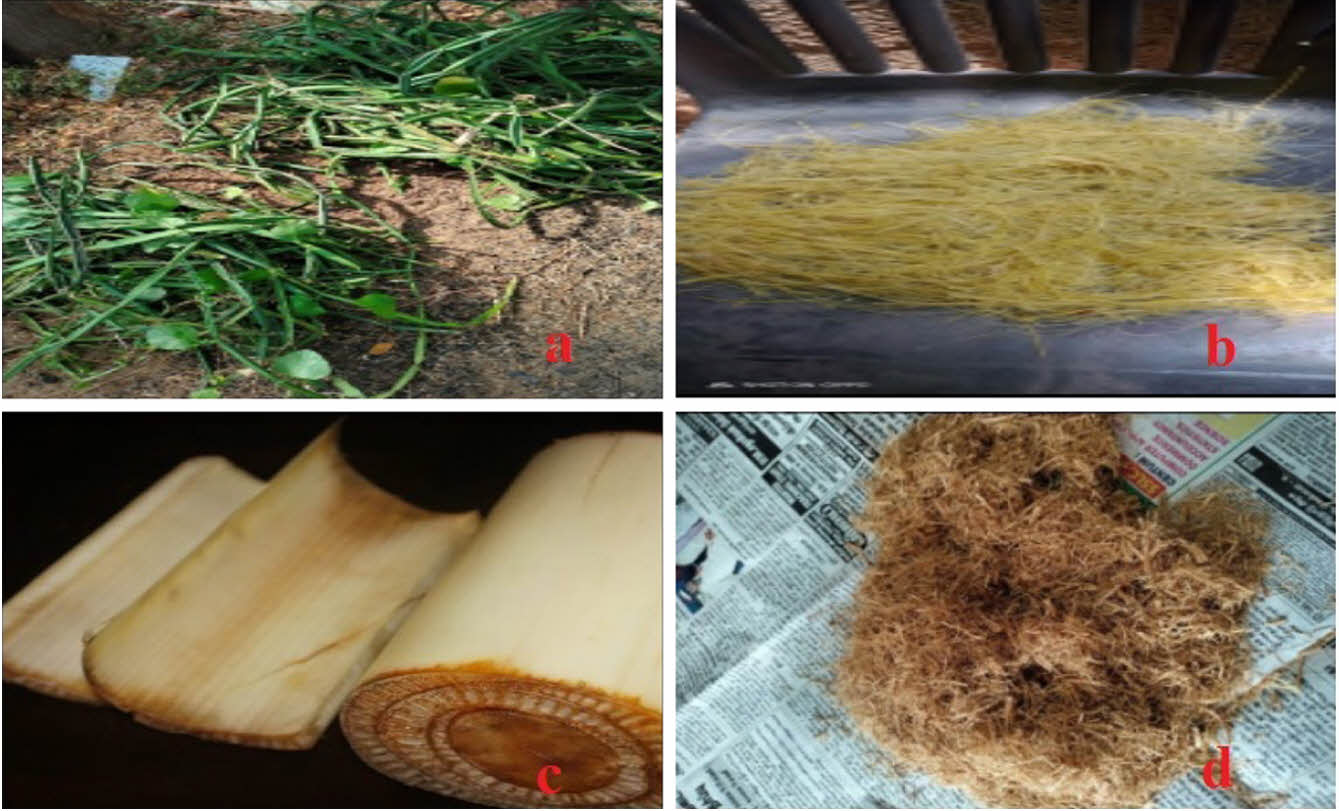
|
Figure 1 Fibre Extraction: (a) cisuss quadrangularis stem; (b) cissus quadrangularis fiber; (c) banana stem; (d) banana fiber. |

|
Figure 2 Fibre treatment. |

|
Figure 3 FTIR results of fibre treatments CQF: (a) before; (b) after BF; (c) before; (d) after |
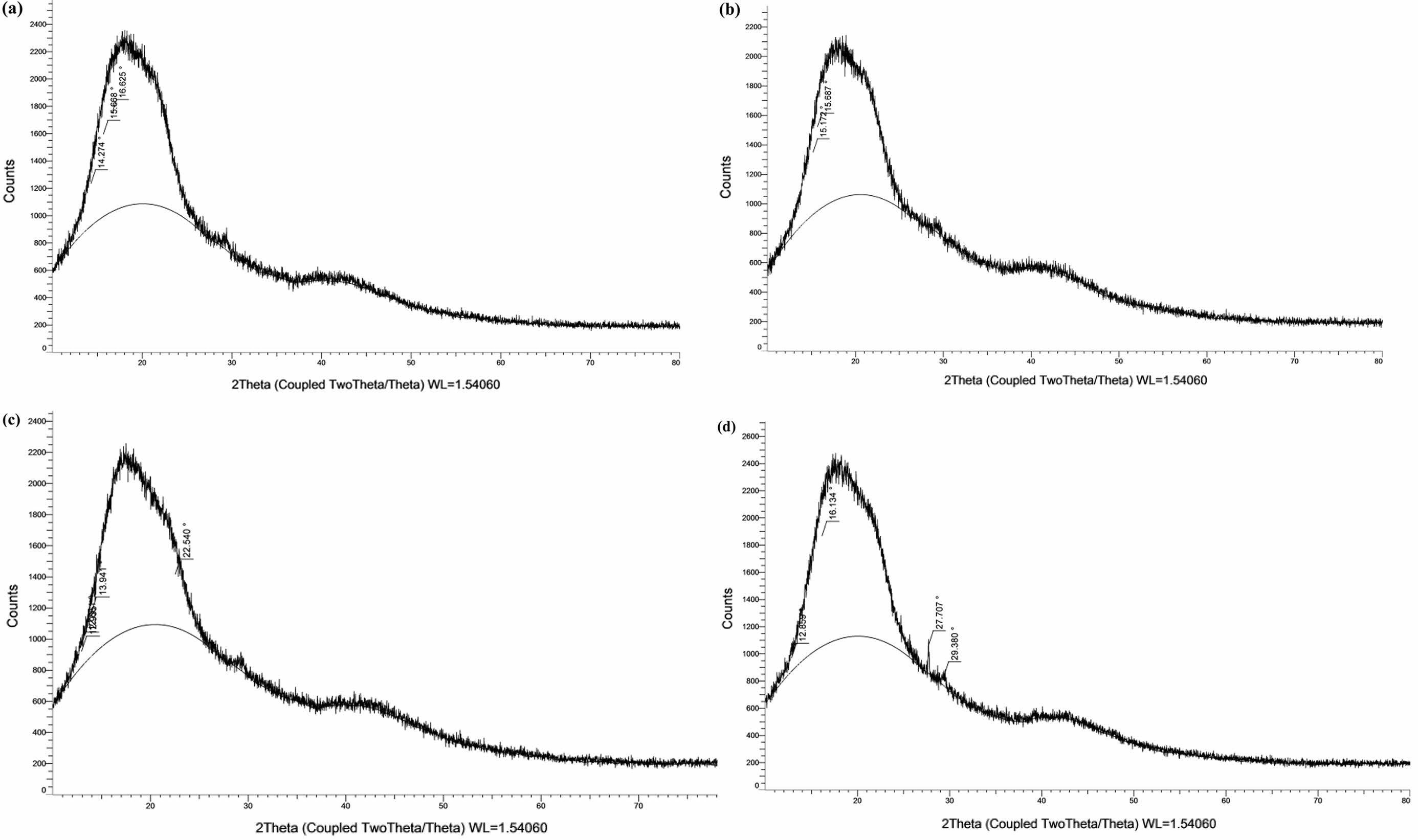
|
Figure 4 XRD results of fibre treatments CQF: (a) before; (b) after BF; (c) before; (d) after. |

|
Figure 5 SEM images magnification 4000x fibre treatments CQF: (a) before; (b) after; BF: (c) before; (d) after. |
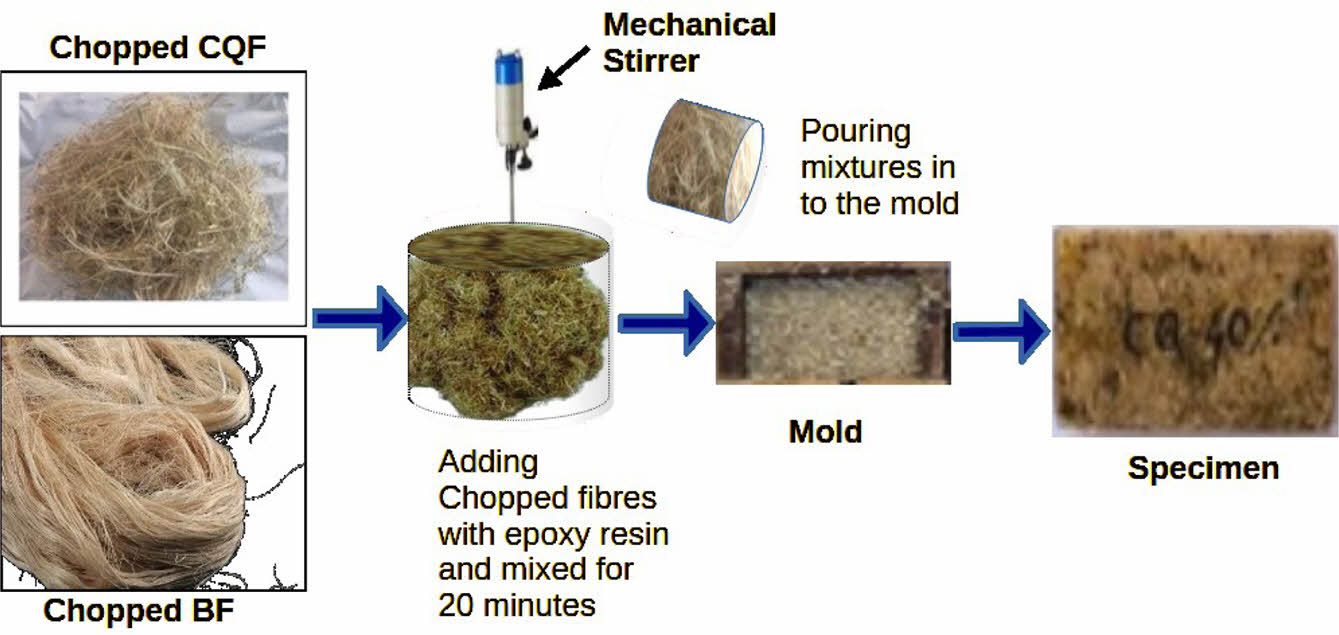
|
Figure 6 Manufacturing process of the composite specimen. |
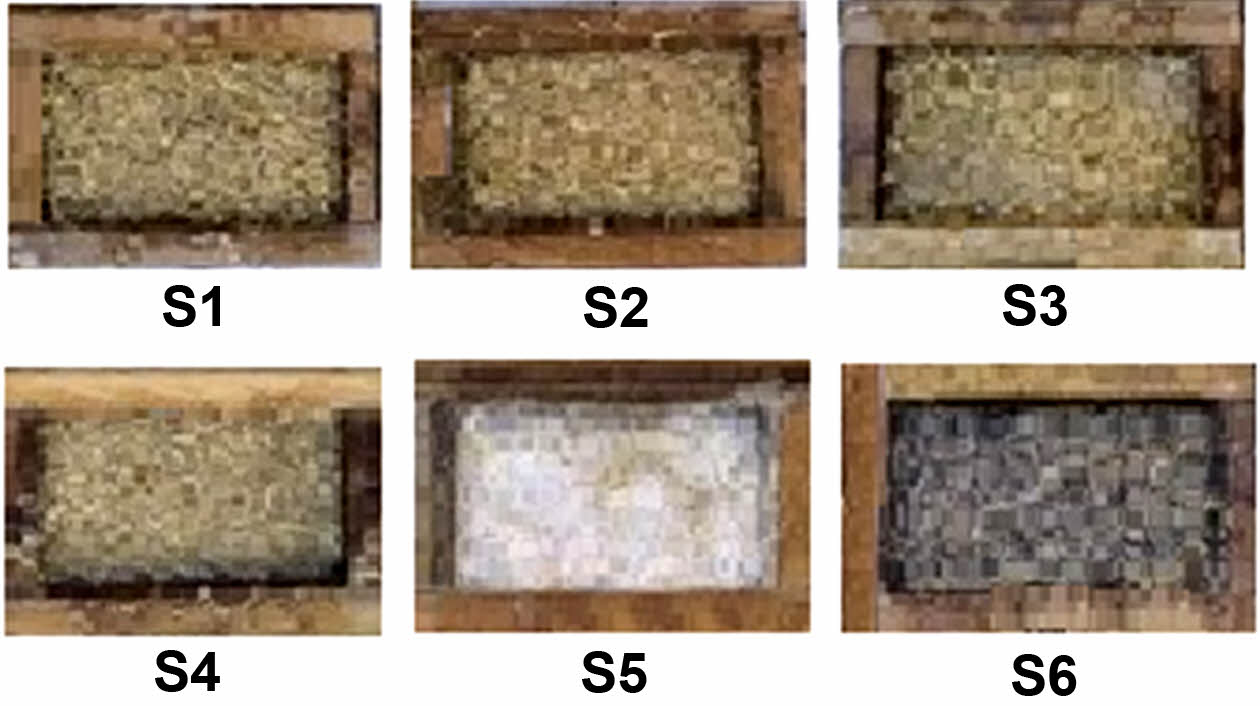
|
Figure 7 Prepared composite specimens. |
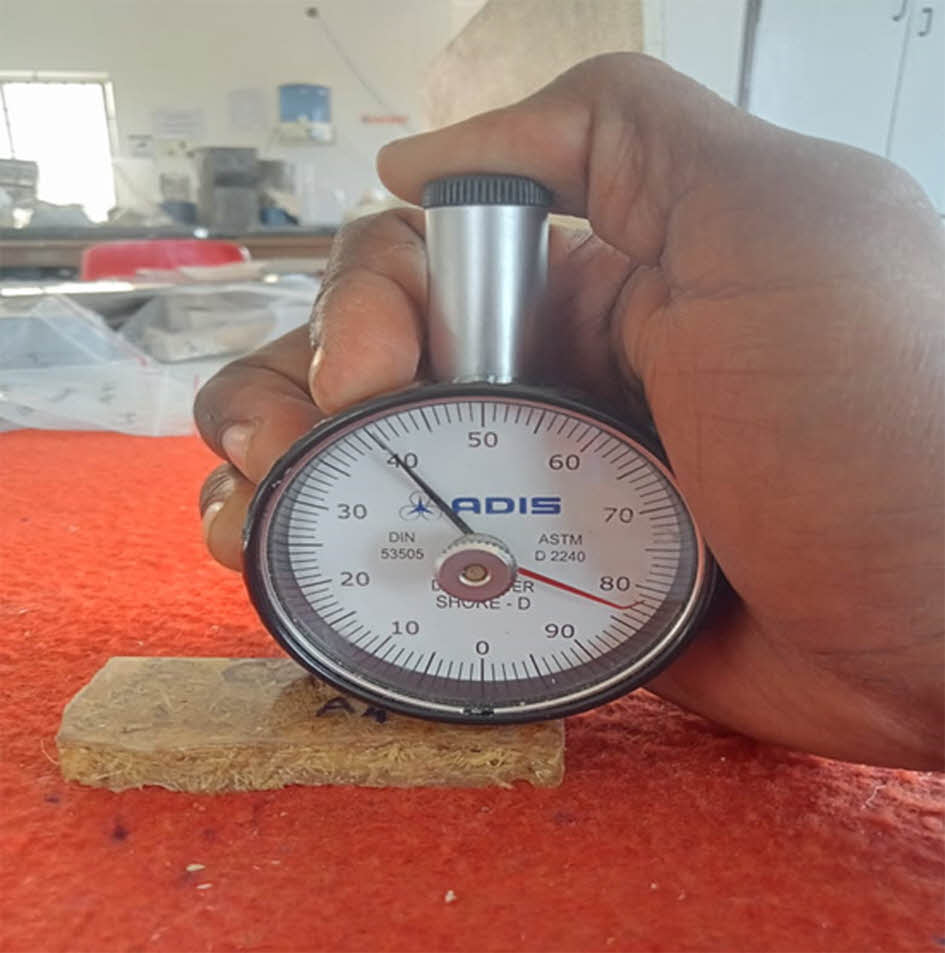
|
Figure 8 Hardness measurement. |
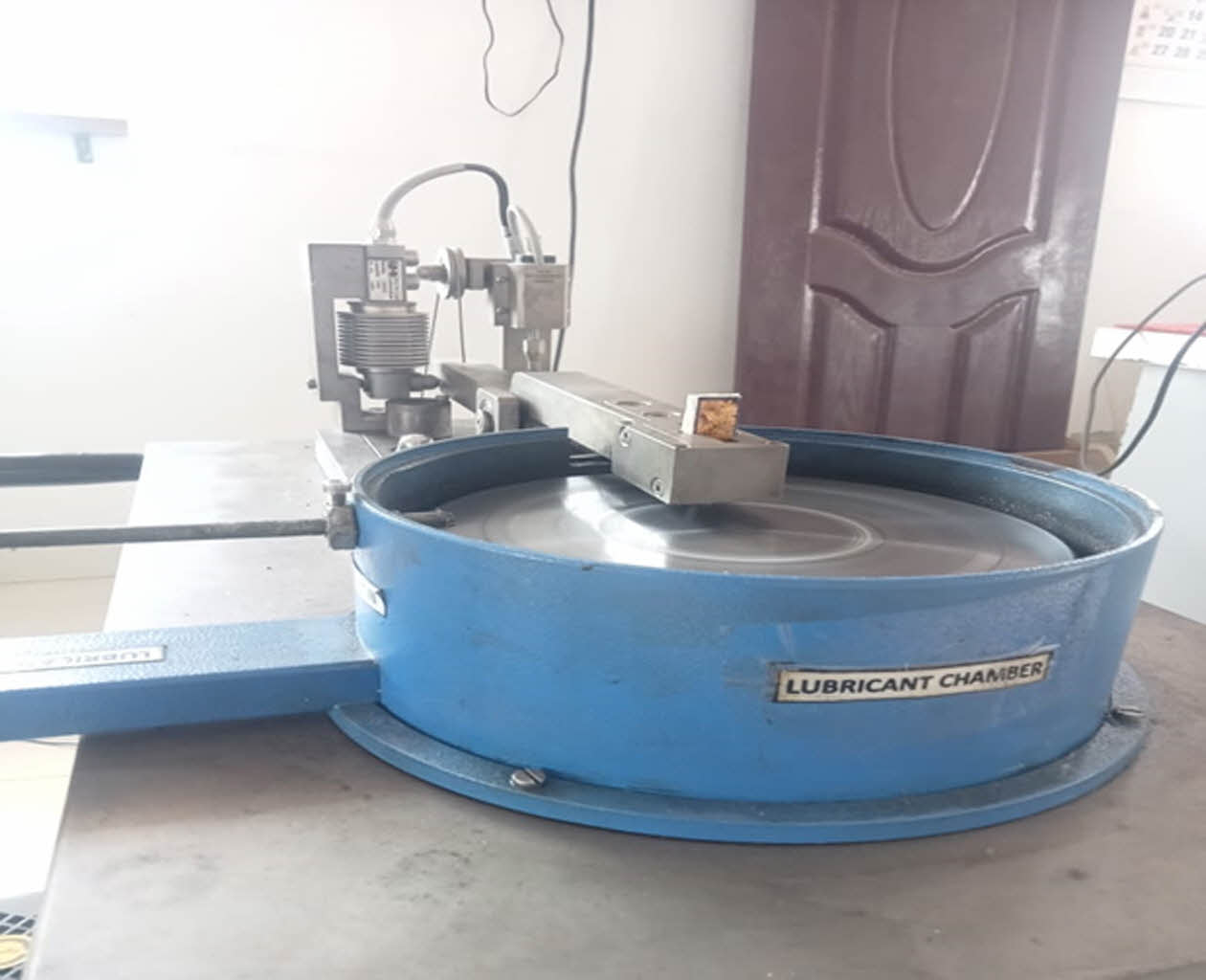
|
Figure 9 Tribometer |
Hardness. The hardness of the samples varies, with S5 having the highest value at 84.6, indicating it is the most rigid and least flexible, followed by S4 at 82. S1 and S2 exhibit similar moderate hardness values at 77 and 76, respectively, suggesting balanced rigidity and flexibility. S6, with a hardness of 75.4, is slightly less rigid than S1 and S2. S3 has the lowest hardness value at 72.2, making it the softest and most flexible sample.
In contrast, sample S3, with a hardness of 75.4, is the softest, possibly due to lower cross-linking density, different filler content, or variations in processing conditions. Samples S1, S2, S4, and S6 fall between these extremes, with S4 (82) and S1 (77) closer to the higher end, and S2 (76) and S1 (77) nearer to the lower end. The results of specimen hardness are shown in Table 3 and Figure 10.
The relatively small range of hardness values suggests that the samples are likely produced from a similar base material with slight variations in formulation or processing. Consistent material properties are crucial for ensuring predictable performance in applications. Samples with higher hardness, such as S4 and S5, might be preferred for applications requiring higher resistance to deformation and wear, while samples with lower hardness, like S6, could be advantageous in applications where some degree of flexibility or impact resistance is desired.
Wear Rate Analysis. The wear rates among the samples show that S2 has the lowest wear rate at 9.91505 × 10−10 Kg/Nm, indicating the highest resistance to wear. S3, S4, and S5 all share a wear rate of 1.98301 × 10−9 Kg/Nm, demonstrating good wear resistance but not as high as S2, S6, with a wear rate of 2.97451 × 10−9 Kg/Nm, has lower wear resistance compared to S3, S4, and S5. S1 exhibits the highest wear rate at 3.96602 × 10−9 Kg/Nm, indicating the least resistance to wear. The results of specimen hardness are shown in Table 3 and Figure 11.
Coefficient of Friction Analysis. The coefficients of friction for the samples indicate varying levels of resistance to sliding. S2 has the highest coefficient of friction at 0.70, indicating the most resistance to sliding, followed closely by S4 at 0.68 and S5 at 0.65. S6 shows moderate frictional properties with a coefficient of friction of 0.57, while S3 also has a moderate value of 0.54. S1 has the lowest coefficient of friction at 0.47, indicating the least resistance to sliding. .The results are shown in Table 3 and Figure 12.

|
Figure 10 Hardness value of prepared specimens. |
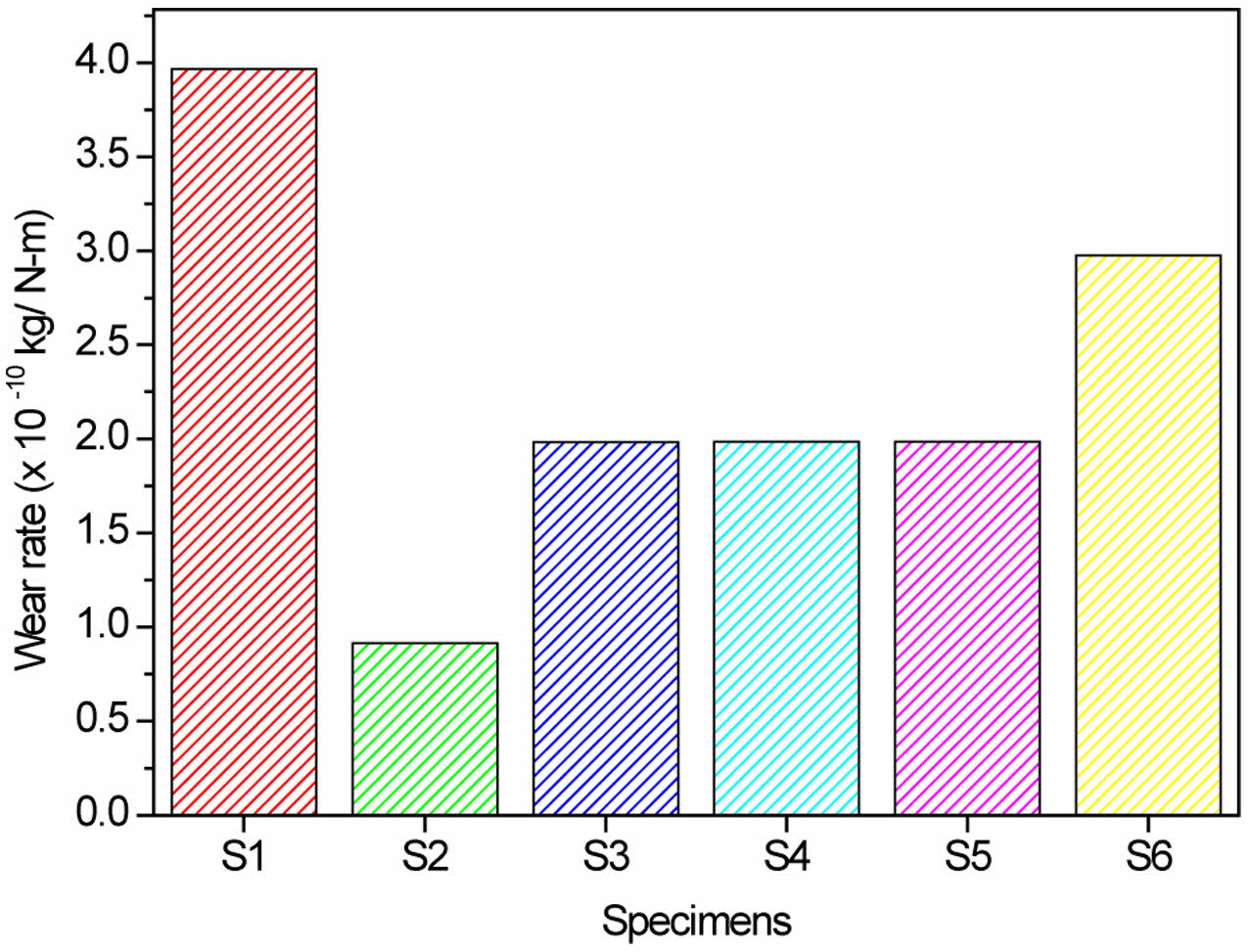
|
Figure 11 Wear rate of prepared specimens |
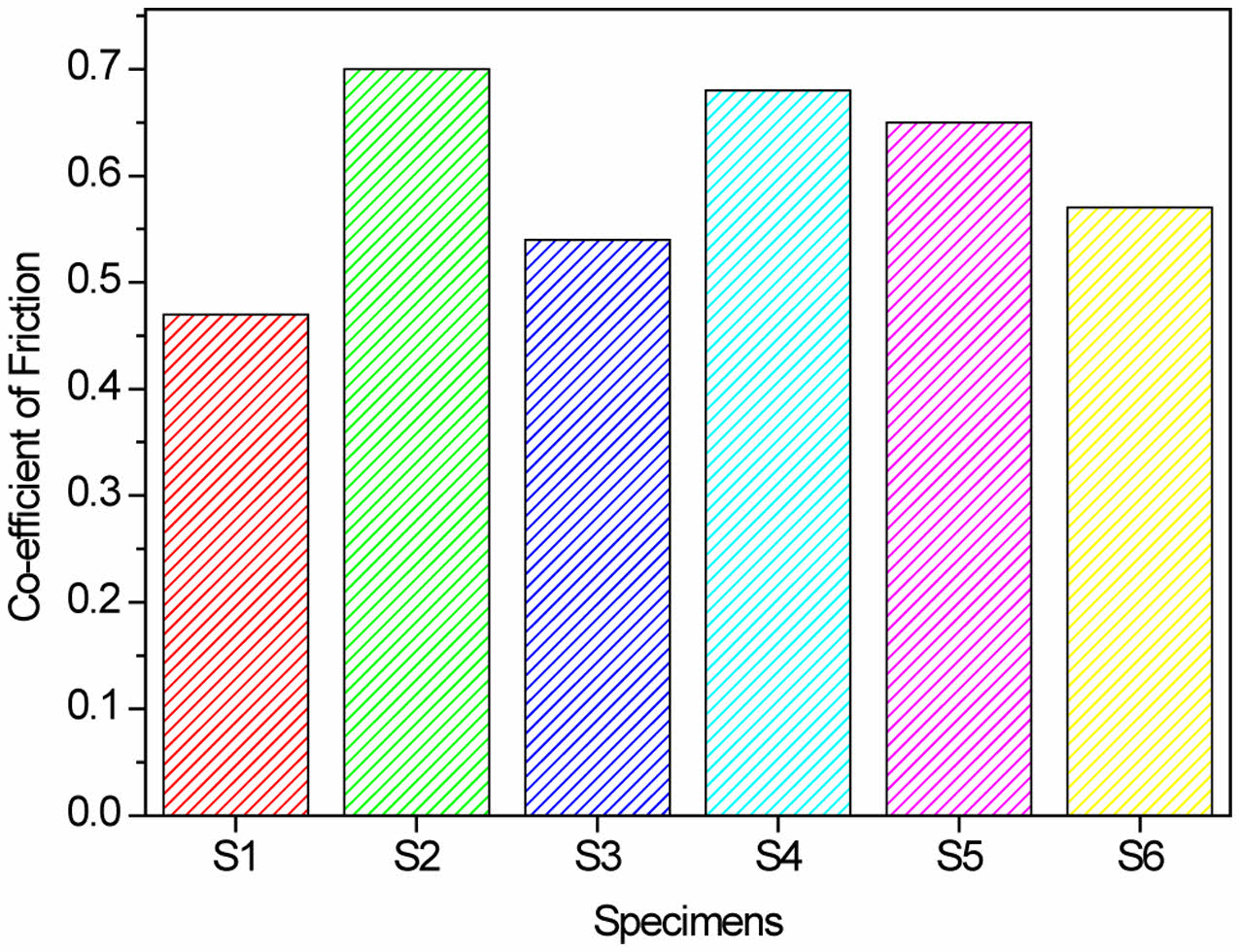
|
Figure 12 Coefficient of friction of prepared specimens |
In this study ciscuss quadrangularis and banana fibers are extacted mechanically and it is chopped.The chopped fibers are subject to alkali treatment. The FTIR, XRD, and SEM analysis are carried out before and after alkali treatment. After alkali treatment, the chopped fibers (reinforcement) are mixed mechanically with epoxy resin (matrix) and finally six composite specimens are S1,S2, S3, S4, S5 and S6 are prepared with the ratio of CSQ:BF (0:100, 20:80, 40:60, 60:40, 80:20, 100:0). For the prepared specimen the different tests such as mechanical analysis for hardness, tribological analysis for wear rate and coefficient of friction is carried out. Based on the comprehensive analysis of fiber treatments and mechanical properties, it is shows that the treatments significantly alter the structural and crystalline characteristics of both Cissus quadrangularis and banana fibers. The FTIR and XRD analyses confirm notable shifts in functional groups and crystallinity, respectively, indicating effective modification. SEM observations highlight varied effects of calcium hydroxide treatment on fiber surfaces, with Cissus quadrangularis showing smoother surfaces but some degradation compared to banana fibers. For hardness test the specimen S5 exhibits higher hardness. Samples S2 demonstrate superior wear resistance and S2 specimen has high coefficient of friction. Overall, these findings underscore the efficacy of the treatments in enhancing fiber properties, with implications for diverse industrial applications.
Highlights. After alkaline treatment of fibers
• FTIR: Possible formation of new compounds such as calcium carbonate
• XRD: Formation of new crystalline phases such as calcium silicate hydrates or calcium carbonate. Possible phase transformations due to treatment.
• SEM: Physical changes and deposition of treatment products.
• Specimen S5 shows maximum hardness.
• Specimens S2 shows the maximum wear rate.
• Specimens S2 show the maximum coefficient of friction.
- 1. Elfaleh, I.; Abbassi, F.; Habibi, M.; Ahmad, F.; Guedri, M.; Nasri, M.; Garnier, C. A Comprehensive Review of Natural Fibers and Their Composites: An Eco-Friendly Alternative to Conventional Materials. Results Eng. 2023, 11, 24-37.
-

- 2. Skosana, S. J.; Khoathane, C.; Malwela, T. Driving Towards Sustainability: A Review of Natural Fiber Reinforced Polymer Composites for Eco-Friendly Automotive Light-Weighting. J. Thermoplast. Compos. Mater. 2024, 38, 754-780.
-

- 3. Naghdi, R. Advanced Natural Fibre-Based Fully Biodegradable and Renewable Composites and Nanocomposites: A Comprehensive Review. Int. Wood Prod. J. 2021, 12, 178-193.
-

- 4. Asyraf, M. R. M.; Ng, L. F.; Khoo, P. S.; Yahya, M. Y.; Hassan, S. A.; Madenci, E.; Khan, T. Lignocellulosic Abaca Fibre-Reinforced Thermoplastic Composites as Future Sustainable Structural Materials: A Bibliometric Analysis and Literature Review. Cellulose 2024, 31, 5419-5459.
-

- 5. Golieskardi, A.; Hoque, M. E.; Golieskardi, M. Introduction to Green Biocomposites. In Green Biocomposites for Biomedical Engineering; Elsevier, 2021, 4, 3-18.
-

- 6. Hong, Y.; Lee, S. Characteristics of Eco-Friendly Epoxy Resin Modified with Epoxidized Soybean Oil (ESO): Thermal, Mechanical and Morphological Properties. Polym. Korea 2024, 48, 133-141.
-

- 7. Bodur, M. S.; Baysan, A. A.; Komurlu, M. U.; Avci, A. Investigations on the Mechanical Properties of PC and ABS Electrospun Nanofiber Embedded Glass Fiber Reinforced Composite. Polym. Korea 2023, 47, 117-126.
-

- 8. Prakash, V.; Pradhan, S.; Acharya, S. K. Tribological Behavior of Syngonanthus Nitens Natural Fiber Reinforced Epoxy Composite. Trans. Indian Inst. Met. 2021, 74, 1741-1750.
-

- 9. Jenish, I.; Gandhi, V. C. S.; Raj, R. E.; Basavarajappa, S.; Indran, S.; Divya, D.; Kumaravelan, R. A New Study on Tribological Performance of Cissus quadrangularis Stem Fiber/Epoxy with Red Mud Filler Composite. J. Nat. Fibers 2022, 19, 3502-3516.
-

- 10. Iyyadurai, J.; Gandhi, V. C. S.; Suyambulingam, I.; Rajeshkumar, G. Sustainable Development of Cissus quadrangularis Stem Fiber/Epoxy Composite on Abrasive Wear Rate. J. Nat. Fibers 2022, 19, 9283-9295.
-

- 11. Gandhi, V. C. S.; Jenish, I.; Indran, S.; Rajan, D. Y. Mechanical and Thermal Analysis of Cissus quadrangularis Stem Fiber/ Epoxy Composite with Micro-Red Mud Filler Composite for Structural Application. T INDIAN I METALS 2022, 75, 737-747.
-

- 12. Sreeraman, N.; Sathish Gandhi, V. C.; Surendiran, T.; Kumaravelan, R. Mechanical, Thermal, and Morphological Behaviour Studies on Coconut Shell and Palm Kernel Filler Biocomposite. Maderas. Cienc. Tecnol. 2022, 24, 1-14.
-

- 13. Chandrasekaran Sasikumar, Murugesan Vijay Anand, Rangasamy Gukendran, & Mani Sambathkumar. Study on Mechanical Properties of Coconut Peduncle Fibers. Polym. Korea 2025, 49, 86-96.
-

- 14. Sankarathil, A. J.; Raja, R.; Vijay, S. J.; Jannet, S.; Kurien, R. A. Structural, Thermal and Elemental Investigations in Epoxy Polymer Composites Reinforced with NaOH-Treated Short Areca Nut Fibers. Trans. Indian Inst. Met. 2023, 76, 2525-2533.
-

- 15. Gokul, K. Prabhu, T. R.; Rajasekaran, T. Processing and Evaluation of Mechanical Properties of Sugarcane Fiber Reinforced Natural Composites. Trans. Indian Inst. Met. 2017, 70, 2537-2546.
-

- 16. Thandavamoorthy, R.; Devarajan, Y.; Kaliappan, N. Antimicrobial, Investigation on CQSF Reinforced Novel Polymeric Composite with Banana chopped fiber for Green Engineering Applications 11 Polym. Korea, Vol. 49, No. 4, 2025 Function, and Crystalline Analysis on the Cellulose Fibre Extracted from the Banana Tree Trunks. Sci. Rep. 2023, 135, 1348-1357.
-

- 17. Kar, A.; Saikia, D. Characterization of New Natural Cellulosic Fiber from Calamus Tenuis (Jati Bet) Cane as a Potential Reinforcement for Polymer Composites. Heliyon 2023, 9, e16491.
-

- 18. Selvaraj, M.; Pannirselvam, N.; Ravichandran, P. T.; Mylsamy, B.; Samson, S. Extraction and Characterization of a New Natural Cellulosic Fiber from Bark of Ficus Carica Plant as Potential Reinforcement for Polymer Composites. J. Nat. Fibers 2023, 20, 2194699.
-

- 19. Kumar, R.; Rakesh, P. K.; Sreehari, D.; Kumar, D.; Naik, T. P. Experimental Investigations on Material Properties of Alkali Retted Pinus Roxburghii Fiber. Biomass Convers. Biorefin. 2024, 14, 21345-21361.
-

- 20. Chakravarthy, S.; Madhu, S.; Raju, J. S. N.; Md, J. S. Characterization of Novel Natural Cellulosic Fiber Extracted from the Stem of Cissus Vitiginea Plant. Int. J. Biol. Macromol. 2020, 161, 1358-1370.
-

- 21. Jeong, H. D.; Kim, Y. C. Study on the Thermal and Physical Properties of Nylon 6/Carbon Filler Composites Applying Master-batch. Polym. Korea 2024, 48, 305-311.
-

- 22. Mishfa, K. F.; Alim, M. A.; Repon, M. R.; Habibullah, M. D.; Tonmoy, M. A. H.; Jurkonien?, S.; Shukhratov, S. Preparation and Characterization of Snake Plant Fiber Reinforced Composite: A Sustainable Utilization of Biowaste. SPE Polymers 2024, 5, 35-44.
-

- 23. Oyewo, A. T.; Oluwole, O. O.; Ajide, O. O.; Omoniyi, T. E.; Akhter, P.; Hamayun, M. H.; Kang, B. S.; Park, Y. K.; Hussain, M. Physico-Chemical, Thermal and Micro-Structural Characterization of Four Common Banana Pseudo-Stem Fiber Cultivars in Nigeria. J. Nat. Fibers 2023, 20, 2167031.
-

- 24. Mahendran, N.; Anand, B.; Rajarajan, M.; Muthuvel, A.; Mohana, V. Green Synthesis, Characterization and Antimicrobial Activities of Silver Nanoparticles Using Cissus Quadarangularis Leaf Extract. Mater. Today Proc. 2022, 49, 2620-2623.
-

- 25. Siva, R.; Mobithis, M.; Ravichandran, R.; Valarmathi, T. N.; Jeevahan, J. J.; Sangeetha, M. Characterization of Mechanical, Chemical Properties and Microstructure of Untreated and Treated Cissus quadrangularis Fiber. Mater. Today Proc. 2021, 47, 4479- 4483.
-

- 26. Anand, P.; Rajesh, D.; Senthil Kumar, M.; Saran Raj, I. Investigations on the Performances of Treated Jute/Kenaf Hybrid Natural Fiber Reinforced Epoxy Composite. J. Polym. Res. 2018, 25, 94.
-

- 27. Manimaran, P.; Pillai, G. P.; Vignesh, V.; Prithiviraj, M. Characterization of Natural Cellulosic Fibers from Nendran Banana Peduncle Plants. Int. J. Biol. Macromol. 2020, 162, 1807-1815.
-

- 28. Rajesh, M.; Jayakrishna, K.; Sultan, M. T. H.; Manikandan, M.; Mugeshkannan, V.; Shah, A. U. M.; Safri, S. N. A. The Hydroscopic Effect on Dynamic and Thermal Properties of Woven Jute, Banana, and Intra-Ply Hybrid Natural Fiber Composites. J. Mater. Res. Technol. 2020, 9, 17761-17777.
-

- 29. Pothan, L. A.; Oommen, Z.; Thomas, S. Dynamic Mechanical Analysis of Banana Fiber Reinforced Polyester Composites. Compos. Sci. Technol 2003, 63, 25-33.
-

- 30. Shanmugam, V.; Rajendran, D. J. J.; Babu, K.; Rajendran, S.; Veerasimman, A.; Marimuthu, U.; Singh, S.; Das, O.; Neisiany, R. E.; Hedenqvist, M. S.; Berto, F.; Ramakrishna, S. The Mechanical Testing and Performance Analysis of Polymer-Fibre Composites Prepared through the Additive Manufacturing. Polym. Test. 2021, 3, 106925.
-

- 31. Sun, S.; Pillay, S.; Ning, H. Mechanical Behaviors of Composites Made of Natural Fibers through Environmentally Friendly Treatment. J. Thermoplast. Compos. Mater. 2024, 37, 3715-3734.
-

- 32. Nijjar, S.; Sudhakara, P.; Sharma, S.; Saini, S. Overview on the Latest Trend and Development on Mechanical, Tribological & Microstructural Properties of Natural Fibre Polymer Composites. Mater. Today. Proc. 2022, 63, 663-672.
-

- 33. Suyambulingam, I.; Iyyadurai, J.; Arockiasamy, F. S.; Divakaran, D.; Siengchin, S. Tribological Characterization and Performance of Biocomposites. In Biocomposites-Bio-based Fibers and Polymers from Renewable Resources; Elsevier, 2024, 117-142.
-

- 34. Behera, S.; Gautam, R. K.; Mohan, S.; Chattopadhyay, A. Hemp Fiber Surface Modification: Its Effect on Mechanical and Tribological Properties of Hemp Fiber Reinforced Epoxy Composites. Polym. Compos. 2021, 42, 25-36.
-

- 35. Jariwala, H.; Jain, P. A. Review on Mechanical Behavior of Natural Fiber Reinforced Polymer Composites and Its Applications. J. Reinf. Plast. Compos. 2019, 5, 11-21.
-

- 36. Ahmadijokani, F.; Alaei, Y.; Shojaei, A.; Arjmand, M.; Yan, N. Frictional Behavior of Resin-Based Brake Composites: Effect of Carbon Fibre Reinforcement. Wear 2019, 3, 420-421.
-

- 37. Shalwan, A.; Yousif, B. F. In State of Art: Mechanical and Tribological Behaviour of Polymeric Composites Based on Natural Fibres. Mater. Des. 2013, 48, 253-259.
-

- 38. Singh, T.; Singh, V.; Ranakoti, L.; Kumar, S. Optimization on Tribological Properties of Natural Fiber Reinforced Brake Friction Composite Materials: Effect of Objective and Subjective Weighting Methods. Polym. Test. 2023, 3, 1073-1078.
-

- 39. Kim D. H.; Kim, Y. C. Study on the Physical Properties of PP/ Kenaf Fiber Composite According to Fiber Length and Grafted Degree of Maleic Anhydride. Polym. Korea 2024, 48, 384-389.
-

- 40. Saha, A.; Kulkarni, N. D.; Kumari, P. Development of Bambusa Tulda Fiber-Micro Particle Reinforced Hybrid Green Composite: A Sustainable Solution for Tomorrow’s Challenges in Construction and Building Engineering. Constr Build. Mater. 2024, 441, 1374- 1386.
-

- 41. Feng, Y.; Hao, H.; Lu, H.; Chow, C. L.; Lau, D. Exploring the Development and Applications of Sustainable Natural Fiber Composites: A Review from a Nanoscale Perspective. Compos. B Eng. 2024, 11, 1354-1369.
-

- 42. Babu, T. N.; Shyam, S.; Kaul, S.; Prabha, D. R. Natural Fibre Composites-an Alternative to Plastics in the Automotive Industry: A Review. Proceedings of the Institution of Mechanical Engineers, Part L. J. Mater. Design Appl. 2022, 236, 237-266.
-

- 43. Adekomaya, O.; Majozi, T. Industrial and Biomedical Applications of Fiber Reinforced Composites. In Fiber Reinforced Composites; Elsevier, 2021, 753-783.
-

- 44. Prasad, P. S.; Guerrero, J. D. M.; Kumar, P. Natural and Synthetic Fiber-Filled Polymer Composites Used as Anticorrosive Materials. In Polymer Composites: From Computational to Experimental Aspects; Springer, 2024, 181-202.
-

- 45. Musa, A. A., Onwualu, A. P. Potential of Lignocellulosic Fiber Reinforced Polymer Composites for Automobile Parts Production: Current Knowledge, Research Needs, and Future Direction. Heliyon 2024, 3, 225-235.
-

- 46. Arif, Z. U.; Khalid, M. Y.; Sheikh, M. F.; Zolfagharian, A.; Bodaghi, M. Biopolymeric Sustainable Materials and Their Emerging Applications. J. Environ. Chem. Eng. 2022, 10, 1059-1081.
-

- 47. Raja, T.; Al-Otibi, F. O.; Alharbi, R. I.; Mohanavel, V.; Velmurugan, P.; Karthikeyan, S.; Perumal, M.; Basavegowda, N. A Novel Study of Biological and Structural Analysis on Cissus quadrangularis Fiber-Reinforced CaO Particulates Epoxy Composite for Biomedical Application. J. Mater. Res. Technol. 2023, 27, 692-702.
-

- 48. Indran, S.; Raja, S.; Divya, D.; Rajeshkumar, G. Novel Plant, Their Composites and Applications. Plant Fibers, Their Compos. Appl. 2022, 60, 437-456.
-

- 49. Chakravarthy, S.; Madhu, S.; Raju, J. S. N.; Md, J. S. Characterization of Novel Natural Cellulosic Fiber Extracted from the Stem of Cissus Vitiginea Plant. Int. J. Biol. Macromol. 2020, 161, 1358-1370.
-

- 50. Chandra Mohan, H. K.; Gnanendra Reddy, G. V.; Chowde Gowda, M. Physical and Mechanical Behaviour of Sida acuta Fibre Reinforced Epoxy Composite at Different Fibre Loading. Trans. Indian Inst. Met. 2018, 71, 2105-2117.
-

- Polymer(Korea) 폴리머
- Frequency : Bimonthly(odd)
ISSN 2234-8077(Online)
Abbr. Polym. Korea - 2024 Impact Factor : 0.6
- Indexed in SCIE
 This Article
This Article
-
2025; 49(4): 401-410
Published online Jul 25, 2025
- 10.7317/pk.2025.49.4.401
- Received on Oct 22, 2024
- Revised on Mar 18, 2025
- Accepted on Mar 18, 2025
 Services
Services
- Full Text PDF
- Abstract
- ToC
- Acknowledgements
- Conflict of Interest
Introduction
Experimental
Results and Discussion
Conclusions
- References
Shared
 Correspondence to
Correspondence to
- Veeramalai Chinnasamy Sathish Gandhi
-
Department of Mechanical Engineering, University College of Engineering, BIT Campus, Anna University, Tiruchirappalli - 620024, Tamilnadu, India.
- E-mail: vcsgandhi@gmail.com
- ORCID:
0000-0001-9977-6324







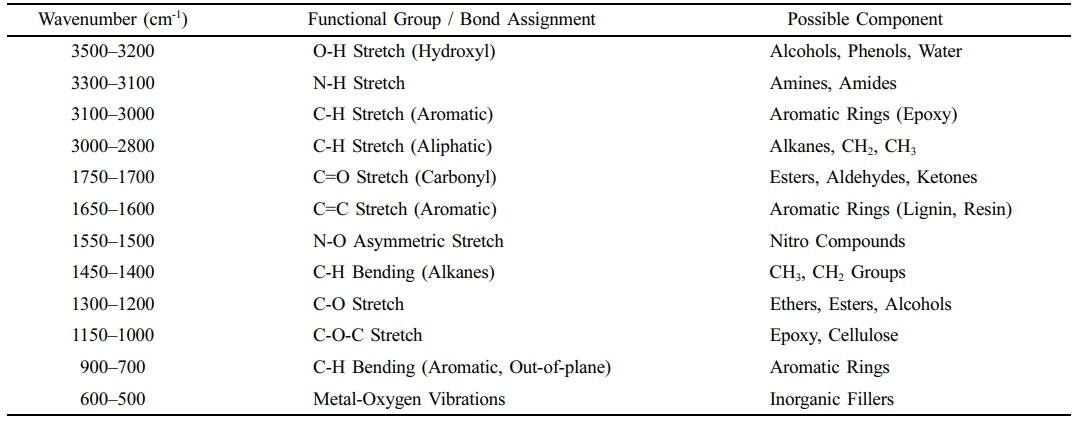
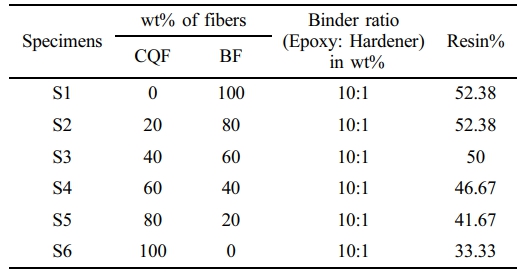
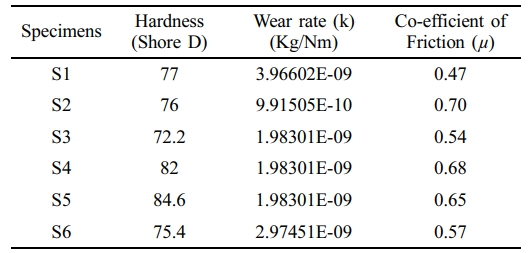
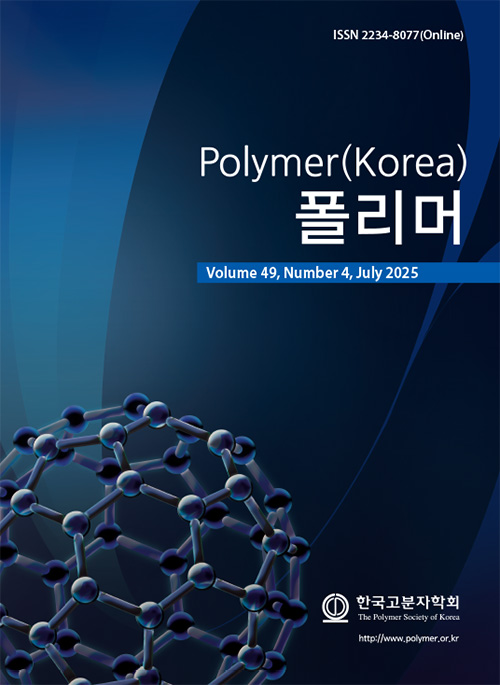
 Copyright(c) The Polymer Society of Korea. All right reserved.
Copyright(c) The Polymer Society of Korea. All right reserved.